Geckeler K.E., Nishide H. (Eds.) Advanced Nanomaterials
Подождите немного. Документ загружается.

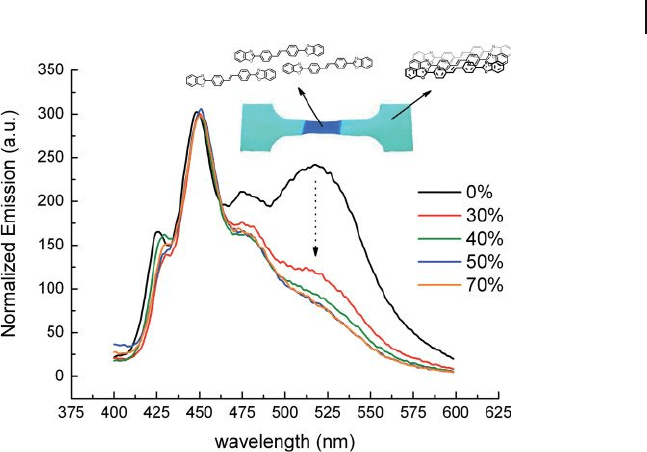
12.2 Organic Chromophores as the Dispersed Phase 385
the data (provided by optical experiments and by quantum - mechanical calcula-
tions) acquired for dispersion of the dyes into the polymer matrix, revealed that
the optical properties and responsiveness to mechanical stimuli were heavily
dependent on the compactness of the perylene aggregates provided by the different
molecular structures of the dyes.
12.2.3
Polymeric Indicators to Thermal Stress
12.2.3.1 Oligo( p - Phenylene Vinylene) as Luminescent Dyes
Another sensing mechanism may be produced, in contrast, by mixing the cyano -
OPVs dyes (or other suitable excimer - forming dyes) with a macromolecular system
characterized by a glass transition temperature ( T
g
) which is above the operating
temperature. Hence, molecularly mixed, glassy composites can readily be pro-
duced via melt processing and rapid quenching of the melts. In this case, the
sensor dyes were kinetically trapped inside the glassy amorphous phase of the host
polymers, namely poly(methyl methacrylate) ( PMMA ) and poly(bisphenyl A car-
bonate) ( PC ), with the formation of thermodynamically stable excimers occurring
just after annealing above T
g
[24] . Subjecting blends of suffi ciently high dye con-
centrations to temperatures above their T
g
- values (130 ° C for PMMA, 150 ° C for
PC) led to permanent and signifi cant changes in the materials ’ emission spectra,
Figure 12.4 Fluorescence emission spectra
( λ
exc.
= 277 nm) of 0.1 wt% poly(1,4 - butylene
succinate)/bis(benzoxazolyl)stilbene fi lm
(PBSBBS - 0.1), before (0%) and after
solid - state drawing (from 30 to 70%
elongation). The spectra are normalized to
the intensity of the isolated BBS molecules
peak (430 nm). Inset: digital image of the
uniaxially oriented PBSBBS fi lm containing the
0.1 wt% of BBS molecules, recorded under
excitation at 366 nm (50% elongation).
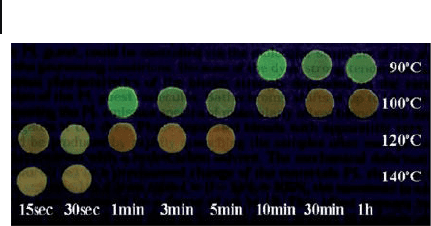
386 12 Optically Responsive Polymer Nanocomposites Containing Organic Functional Chromophores
due to phase separation of the polymer and the excimer - forming dye. This effect
appears to bear signifi cant potential for technological applications, including the
use of dye/polymer blends as time - temperature indicator s ( TTI s). In fact, kinetic
experiments performed as a function of time, temperature and dye concentration,
resulted in some well - fi tted, monoexponential growth functions. In particular,
plotting the rate of aggregation against the inverse of the annealing temperature
indicated the presence of a linear, Arrhenius - type behavior, which suggested that
an aggregation of the dye molecules might be predicted when dispersed into a
polymer fi lm. Moreover, the derived thermodynamic parameters could easily be
determined via luminescence experiments.
Recently, additional data have been acquired by using semicrystalline
[ poly(ethylene terephthalate) ; PET ] and poly(alkyl methacrylate) - based matrices
[25, 35] . Homogeneous blends can be produced by conventional melt - processing
protocols that are concluded with a quenching step, with the materials thus pre-
pared displaying emission spectra characteristic of the dyes ’ monomer emission.
For example, annealing above the T
g
- value of the polyester (80 ° C) led to the forma-
tion of excimers and caused signifi cant changes in the materials ’ emission char-
acteristics. The aggregation processes in the semicrystalline PET/cyano - OPVs
blends investigated appeared to be well - described by single - exponential transfor-
mation kinetics, while the fl uorescence color of these materials was characteristic
of their thermal history (Figure 12.5 ).
In particular, cyano - OPV dyes with a longer, rigid conjugated core showed
slower aggregation rates due to their limited mobility within the polymer
matrix [35] .
An extreme, yet intriguing, application of the multifunctional chromogenic
cyano - OPV dyes was recently reported by Weder et al. [36] . The group reported the
preparation and characterization of a new shape memory polymer ( SMP ) with
built - in temperature - sensing capabilities, by incorporating a cyano - OPV dye into
a semi - crystalline crosslinked poly(cyclo - octene) (PC ’ O) by guest diffusion. SMPs
have the ability to memorize a permanent shape, and so can be manipulated and
fi xed to a temporary shape under specifi c conditions of temperature and stress,
Figure 12.5 Images of initially quenched blends fi lms of
0.9 wt% poly(ethylene terephthalate)/cyano - oligo( p - phenylene
vinylene) upon annealing for the time and at the temperature
indicated ( λ
exc.
= 365 nm). Reproduced with permission from
Ref. [25] ; © 2006, American Chemical Society.
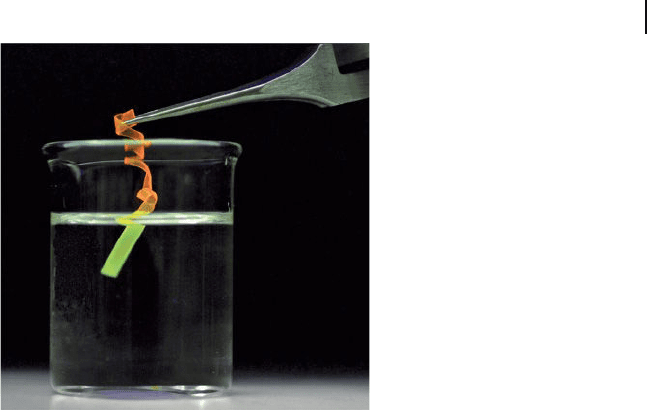
12.2 Organic Chromophores as the Dispersed Phase 387
yet subsequently relax to the original, stress - free state upon application of an
external stimulus [37] . Weder ’ s group described a new SMP/dye system in which
a built - in sensor provided additional functionality. The material was based on a
chromogenic sensor dye that provided a simple and clear signal indicating if the
set/release temperature had been reached. The dye concentration was chosen to
allow dye aggregation upon drying, which resulted in the formation of excimers.
Exposure of these phase - separated blends to temperatures above the melting point
( T
m
= 47 – 48 ° C) of the polymer led to dissolution of the dye molecules, yielding a
pronounced change in their optical characteristics.
Briefl y, the permanent rod - shaped PCO/dye blend was heated to 80 ° C, deformed
to a temporary shape (spiral), and fi xed by cooling to room temperature. The spiral
was slowly immersed into a silicon oil bath (ca. 75 ° C), allowing recovery of the
rod shape which was fl anked by a color change from orange to yellow - green
(Figure 12.6 ).
12.2.3.2 Bis(Benzoxazolyl) Stilbene as Luminescent Dye
Polymeric fi lm sensors that were based on excimer luminescence and responsive
to temperature stress were also obtained through the dispersion of moderate
amounts (0.02 – 0.2 wt%) of the food - grade dye BBS into the thermoplastic aliphatic
biodegradable polyester, PBS, by melt - mixing [33] . Analogous to the cyano - OPVs
polymer blends, rapid quenching at 0 ° C of the PBS - BBS mixtures from the melt
promoted the very fi ne molecular dispersion of BBS dyes that were kinetically
Figure 12.6 Image of the recovery from temporary shape
(spiral, orange emission) to the permanent shape (rod, green
emission) for a crosslinked poly(cyclo - octene)/cyano - oligo( p -
phenylene vinylene) blend. The sample was immersed in
silicon oil at ∼ 75 ° C (under illumination at 365 nm) [36] .
Reproduced with permission of the Royal Society of
Chemistry.
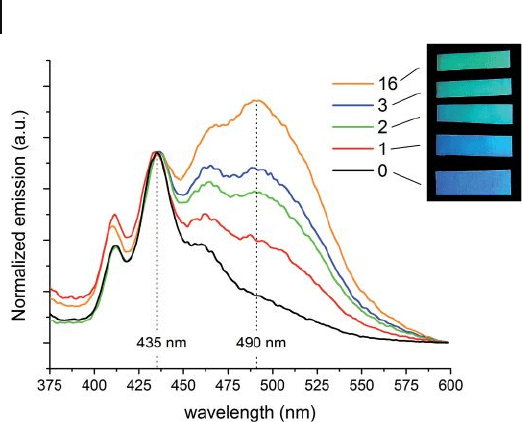
388 12 Optically Responsive Polymer Nanocomposites Containing Organic Functional Chromophores
trapped within the PBS matrix, thus avoiding the formation of excimers. The
luminescent behavior of PBS - BBS - quenched fi lms was thermally controlled, with
BBS aggregation tendencies and emission color changes proportional to the
increasing annealing temperature (from 50 to 80 ° C). The thermal stress applied
to fi lms led to the generation of thermodynamically stable aggregates among BBS
dyes, promoting the color change of the material from blue (emission at 435 nm)
to green (emission at 490 nm) (Figure 12.7 ).
The molecular dispersion of BBS dyes into quenched PBS fi lms should allow a
prompt optical response to thermal stimuli, that was faster with respect to the
isolated dyes incorporated into a glassy amorphous polymer matrix. In the case of
PMMA, this occurred at a lower annealing temperature due to the T
g
value ( − 34 ° C)
of the PBS supporting matrix.
12.2.3.3 Anthracene Triaryl Amine - Terminated Diimide as Luminescent Dye
Another example of thermochromic fl exible materials based on polyethylene was
recently reported [38] in which the authors described the synthesis and incorpora-
tion into PE of a novel anthracene triaryl, amine - terminated diimide fl uorescent
sensor (Scheme 12.2 , 4 ). When incorporated into the polymer (0.1 wt%, by melt -
mixing), the fi lms showed an emission at approximately 620 nm which was pro-
gressively red - shifted by increasing the annealing temperature to 543 nm (green
color) at 150 ° C. Although it is likely that room - temperature emission from the
anthracene diimide - doped PE was due to the formation of molecular aggregates,
Figure 12.7 Fluorescence emission spectra ( λ
exc.
= 277 nm) of
initially quenched 0.05 wt% poly(1,4 - butylene succinate)/
bis(benzoxazolyl)stilbene fi lm, and its color evolution as a
function of the annealing time at 65 ° C. Inset: The same fi lms,
with images recorded under irradiation at 366 nm for specifi ed
times (h).

12.3 Metal Nanostructures as the Dispersed Phase 389
this mechanism cannot fully explain the material ’ s thermochromic behavior in
these fi lms. The authors suggested that heating at 150 ° C led to disruption of the
dye aggregates, while the highly viscous medium of the polymer hampered full
conjugation of the molecule, thus providing the same green emission.
12.3
Metal Nanostructures as the Dispersed Phase
12.3.1
Optical Properties of Metal Nanoassemblies
Today, nanoscience represents one of the most rapidly growing research areas,
allowing the manipulation of matter at the nanoscale and allowing the controlled
fabrication of such systems and devices. Engineered nanoparticles offer potential
applications in many areas benefi cial for humankind, including sensors, medical
imaging, drug delivery systems, sunscreens, cosmetics, and many others [39 – 41] .
Ever since the birth of nanotechnology, it has been clear that the optical properties
of nanostructured metal particles depend heavily not only on their dimensions but
also their shape [42, 43] . The absorption of visible light by metal nanoparticles was
attributed to the induction of a collective oscillation of the free conduction elec-
trons, promoted by their interaction with electromagnetic fi eld. Indeed, when the
wavelength of an incident radiation is comparable with the mean free path of the
conduction electrons of a metal particle, the electric component of the electromag-
netic incident fi eld induces a polarization of the conduction electrons, giving rise
to surface plasmon absorption [43, 44] .
In particular, noble metal nanoparticles or semi - conducting nanocrystals embed-
ded in bulk polymer matrices demonstrate enhanced optical (absorption, lumines-
cence, and nonlinearity) [42, 43, 45 – 51] and magnetic properties [52] , due to the
stabilizing effects of size and aggregation provided by the macromolecular support.
When dispersed into polymers in a nonaggregated form, however, those metal
nanoparticles with very small diameters (a few nanometers) will allow the prepara-
tion of materials with much - reduced light scattering properties for applications as
optical fi lters, linear polarizers, and optical sensors [53, 54] .
For example, clusters of noble metals such as gold, silver, or copper, assume a
real and natural color due to the absorption of visible light at the surface plasmon
resonance ( SPR ) frequency. The application of composites based on polymeric
materials and containing noble metal nanoparticles depends strictly on an ability
to control and to modulate their size, shape, and extent of aggregation. As described
by the Drude – Lorentz – Sommerfeld theory [42, 43] , a decrease in metal particle
size leads to a broadening of the absorption band, a decrease in the maximum
intensity, and often also to a hypsochromic (blue) shift of the peak. These effects
may also depend on cluster topology and packing [44, 55] .
In addition, the anisotropic orientation of dipoles in nanoparticles by a
uniaxially oriented host polymer matrix leads to the generation of two different
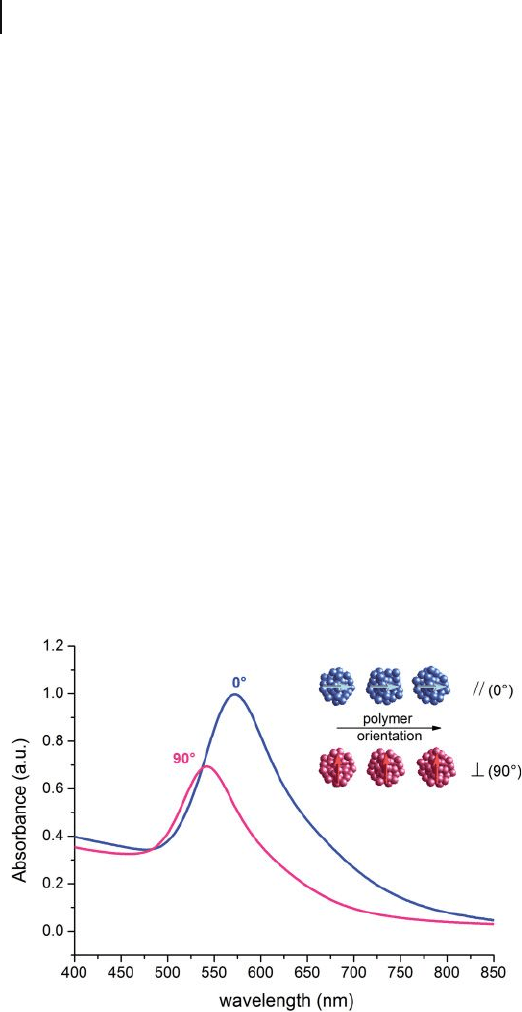
390 12 Optically Responsive Polymer Nanocomposites Containing Organic Functional Chromophores
excitation modes: (i) with photons polarized along the aggregation direction,
leading to a bathochromic (red) shift of the SPR; or (ii) with photons polarized
orthogonally to the aggregation direction, resulting in a hypsochromic (blue) shift
(Figure 12.8 ) [53] .
The most common procedure for obtaining a dispersion of metal nanoparticle s
( MNP s) in a polymer matrix is to prepare a colloidal solution of stabilized MNPs,
to mix this with the desired polymer in a mutual solvent, and then to cast a
fi lm by evaporation from the solution [53] . In contrast, few examples have been
reported demonstrating the dispersion of preformed MNPs in a polymer matrix
by melt - mixing at high temperature [56, 57] .
Usually, a water - soluble metal salt is moved into an organic solvent by
using tetra - alkylammonium bromide as phase - transfer agent, followed by
successive reduction with sodium borohydride in the presence of an alkylthiol as
surface stabilizer to prevent coalescence of the growing nanoparticles [58, 59] .
In addition to thiols, a number of different surface stabilizers have been used,
including amines [60] , poly(vinyl pyrrolidone) ( PVP ) [61] , and sodium poly(acrylate)
[62] . By using the above - described colloid chemistry technique, MNPs have
been dispersed in ultra - high molecular - weight polyethylene ( UHMWPE ) [11,
45] , high - density polyethylene ( HDPE ) [57] , poly(vinyl alcohol) ( PVA ) [53, 63,
64] , poly(dimethylsiloxane) ( PDMS ) [65, 66] , and poly(styrene - b - ethylene/
propylene) [67] .
An alternative approach for preparing nanocomposites containing metal
nanoparticles involves an in situ formation of nanoparticles directly within the
Figure 12.8 I n fl uence of the polarization direction of light on
the surface plasmon resonance (SPR) band of uniaxially
oriented polymer fi lm containing gold nanoparticles. The
polarization direction was either parallel (0 ° ) or perpendicular
(90 ° ) to the drawing axis.
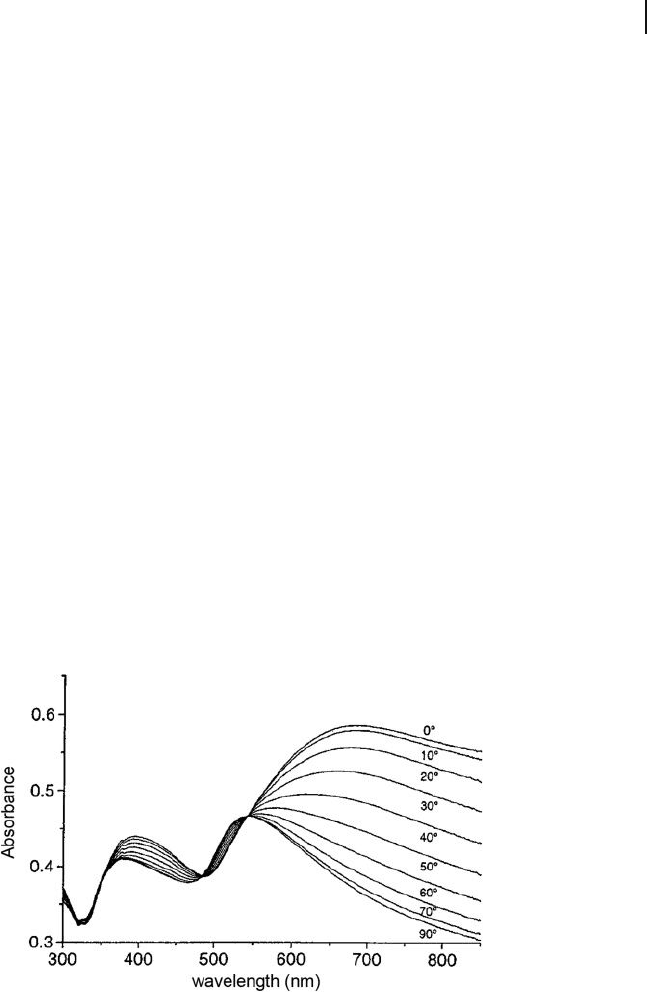
12.3 Metal Nanostructures as the Dispersed Phase 391
polymer matrix [63, 68 – 80] . This process is relatively straightforward and requires
simply a reduction of the metal ions precursors by either a photochemical or
a thermally induced process. However, in contrast to nanoparticles prepared
via colloid chemistry, controlling the size distribution of these in situ - prepared
particles is often more diffi cult due to infl uential factors such as the polymer
matrix composition, and the time and energy density of the photo - or thermo -
irradiation process.
12.3.2
Nanocomposite - Based Indicators to Mechanical Stress
12.3.2.1 The Use of Metal Nanoparticles
Nanoparticle dispersions in a polymer matrix can be rendered macroscopically
anisotropic, a feature that has allowed their use in nonlinear optical devices and
linear absorbing polarizers, for example, in display applications [11, 45, 53, 57,
81 – 83] . Highly dichroic noble metal nanoparticles are effi ciently obtained after
mechanical drawing of the polymer matrix. The uniaxial orientation of the mac-
romolecular fi bers promotes the anisotropic distribution of both the crystalline
and amorphous phases, which then determines the alignment of the metal parti-
cles along the direction of drawing [53, 84] .
Examples of this include PVA and HDPE fi lm composites with alkyl thiol - coated
gold and silver particles which, once uniaxially oriented by stretching, present
angular dependencies of the absorption intensity and the color of the transmitted
light [53] (Figure 12.9 ).
Figure 12.9 UV - visible spectra of drawn nanocomposites
comprising high - density polyethylene and gold nanoparticles,
taken in linearly polarized light at different angles between the
polarization direction of the incident light and the drawing
direction [53] . Reproduced with permission of John Wiley &
Sons, Ltd.

392 12 Optically Responsive Polymer Nanocomposites Containing Organic Functional Chromophores
The absorption of photons is dominated by the excitation of surface plasmons
in the metal particles and their aggregates [42, 43] . For example, drawn polyethyl-
ene/silver nanocomposites exhibited a strongly polarization - dependent color. Yet,
the color of the light transmitted through the oriented nanocomposite shifted from
red to yellow when the angle between the polarization axis of an interposed polar-
izer and the drawing direction of the fi lm was varied from 0 ° to 90 ° [57] .
Moreover, the optical response of metal nanoparticles can be strongly enhanced
through the introduction of photoactive organic molecules, possibly combined
with control of the nanoparticle dimensions [85] . The presence of direct electronic
interactions between metal and metal - bound chromophores is of particular inter-
est, because it could allow for a fi ne modulation of the optical properties by induc-
ing an energy transfer from the excited state of the chromophore to the SPR of
the metal [86, 87] .
For example, the dispersion of gold nanoparticles and gold - binding chromo-
phores in a stretched polymer matrix of PE produces nanocomposites with unusual
and anisotropic optical properties [45] . Strongly dichroic, terthiophene - based
chromophores, which previously had been used in anisotropic PE dispersions for
the preparation of linear polarizers [88] , were modifi ed with a thiol group and used
for the preparation of gold nanoparticles. These authors demonstrated that the
electronic systems of the chromophores were coupled with the gold nanoparticles,
and that the polarization of the absorbed radiation could be preserved during
energy transfer between a chromophore and a metal particle.
An interesting method for the production of dichroic nanocomposites with
a reversible optical response to mechanical stress has been recently reported
[65, 66] . Here, Caseri et al. [65] based their studies on the difference in the trans-
mitted color of gold and silver elastomeric nanocomposites in dry and in swollen
samples, based on the change in interparticle distances which resulted from the
swelling process. Caseri ’ s group showed that a given dry gold – polymer nanocom-
posite could adopt not only one but several colors, and that these colors could be
switched through swelling processes, including reversible and irreversible dich-
roic – monochroic color transitions. A lightly crosslinked rubber such as PDMS was
selected as the supporting polymer matrix, as it can take up large quantities of
solvent without dissolution, and might also afford reversible dichroic effects upon
deformation. The oriented PDMS composite fi lms appeared blue – gray with light
polarized parallel to the drawing axis, and red with light in a perpendicular orienta-
tion; the dichroism was preserved upon removing the strain. Swelling (with
toluene) of the dichroic oriented fi lms caused the specimens to become pink,
indicating that the individual particles in the linear assemblies had disconnected
and turned blue and nondichroic following evaporation of the toluene.
Recently, nanocomposites based on PVA and poly [ethylene - co - vinyl alcohol]
polymers and nanostructured gold have been effi ciently prepared using a UV
photoreduction process [89] . In this case, the polymer matrix based on vinyl
alcohol repeating units, acted both as a coreducing agent, as a protective agent
against particle agglomeration, and as a macroscopic support. The very rapid
process provided dispersed gold nanoparticles with average diameters ranging
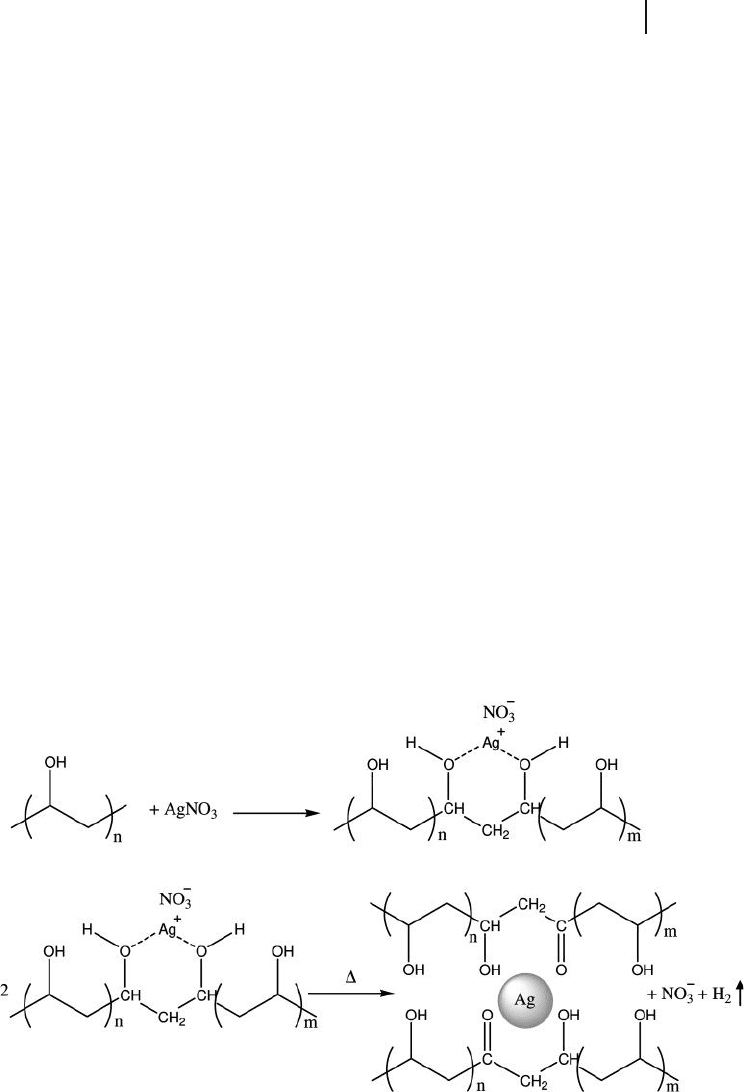
12.3 Metal Nanostructures as the Dispersed Phase 393
from 3 to 20 nm, depending on the host polymer matrix and the irradiation time.
Uniaxial drawing of the Au/polymer composites promoted anisotropic packing of
the embedded gold nanoparticles along the stretching direction of the fi lm, and
this resulted in a shift of the SPR of gold well above 30 – 40 nm (83 nm maximum),
thus producing a well - defi ned polarization - dependent color change from blue to
purple [89] . The optical responsiveness to mechanical stimuli appeared similar
to that reported previously by Smith et al. for optically anisotropic polyethylene –
gold nanocomposites obtained by introducing preformed and annealed alkyl - thiol -
protected gold nanoparticles into polyethylene [81] . The UV photogeneration of
gold nanoparticles directly into a polymer fi lm precursor represents an easier,
faster, and highly competitive technique for the preparation of optically responsive
nanocomposites to mechanical stimuli, however.
Among the large number of hybrid organic – inorganic systems investigated,
those nanocomposites based on PVA and silver have attracted great interest
because of their specifi c optical, catalytic, electronic, magnetic, and antimicrobial
properties [64, 68, 76, 90 – 97] . Recent developments have been focused in this
direction in order to optimize the preparation Ag/PVA nanostructured fi lms by
using alternative “ in situ ” methods such as sun - (UV) [76, 98, 99] or thermally
promoted reduction processes [100] .
These simple and very rapid methods provide dispersed Ag nanoparticles
( < 4 wt%) with average diameters that range from 15 to 150 nm, depending on the
type of preparation [101] . Thermal annealing and UV irradiation in fact form
the basis for these very effi cient methodologies, because they take advantage of
the formation of a complex between the PVA matrix, while silver nitrate [102] : Ag
+
ions can easily be chelated by the hydroxyl groups of the polymer and then reduced
directly in the host matrix (Scheme 12.3 ).
Scheme 12.3 Thermally promoted formation of silver nanoparticles within the PVA matrix.
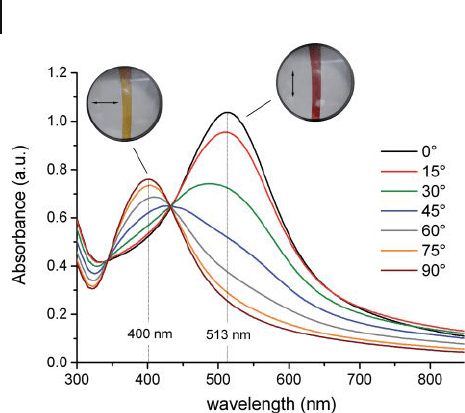
394 12 Optically Responsive Polymer Nanocomposites Containing Organic Functional Chromophores
Ag(0) formation was progressively followed using both UV - visible and Fourier
transform - infrared (FT - IR) spectroscopies, monitoring the evolution of the SPR of
silver (ca. 430 nm) and the carbonyl absorption band of PVA (ca. 1720 cm
− 1
),
respectively [101] .
After uniaxial orientation, the Ag/PVA nanocomposites showed a pronounced
dichroic behavior, based on the anisotropic distribution of the silver assemblies
along the stretching direction. In uniaxially oriented samples, the light absorption
was seen to depend heavily on the angle between the polarization direction of
the incident light and the orientation of the particles embedded onto the host
polymeric matrix. Simply by observing oriented samples through a linear polar-
izer, it is possible to observe that the color of the fi lms depends markedly on the
relative orientation between the polarizer and the drawing direction of the fi lm
(Figure 12.10 ).
The maximum shifts measured for the oriented fi lms were more than 100 nm,
while the spectra showed a well - defi ned isosbestic point, thus confi rming the
existence of two different populations of absorbing nanoparticles [89] . Interest-
ingly, the shift in wavelength of the silver SPR band also occurred at moderate
drawings (draw ratio ≥ 2). The nanocomposite fi lms thus produced were highly
optically responsive to mechanical stimuli as uniaxial deformations.
Analogously, thermochromic fi lms based on silver/polystyrene nanocomposites
have been reported, these being prepared by the thermal annealing of silver
dodecylmercaptide/polystyrene blends at approximately 200 ° C [103 – 105] . It was
shown that alkanethiolates of transition metals dissolved in polymers would
Figure 12.10 UV - visible spectra of oriented sun - promoted
Ag/PVA nanocomposite fi lms as a function of the angle
between the polarization of light and the drawing direction of
the fi lm. The insets show images of the same fi lms under
polarized light.
